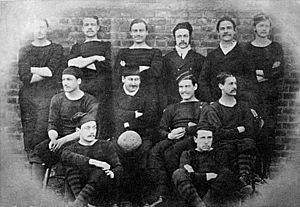William Stafford (British Army officer) facts for kids
Quick facts for kids
William Francis Howard Stafford
|
|
|---|---|
| Born | 19 December 1854 Hansi, India |
| Died | 8 August 1942 (aged 87) Crowthorne, Berkshire, England |
| Buried |
St. John the Baptist Church, Crowthorne
|
| Allegiance | United Kingdom |
| Service/ |
British Army |
| Years of service | 1873–1911, 1915–1918 |
| Rank | Brigadier-General |
| Unit | Royal Engineers |
| Commands held | Commanding Royal Engineer, North-Western District Chief Engineer Southern Command Officer Commanding South Irish Coastal Defences |
| Awards | C.B. |
Brigadier-General William Francis Howard Stafford (born December 19, 1854 – died August 8, 1942) was a brave British Army officer. He was a Brigadier-General in the Royal Engineers, a special part of the army that builds things and helps with engineering. He served in many wars in the late 1800s and early 1900s.
When he was younger, William Stafford was also a talented sportsman. He played rugby for the England team in 1874. He also played soccer for the Royal Engineers team. His team even won the famous 1875 FA Cup Final!
Contents
Early Life and School
William Stafford was born in Hansi, India, on December 19, 1854. His family was a military family. His father, William Joseph Fitzmaurice Stafford, was a major-general in the army. William's two younger brothers also joined the Royal Engineers.
William went to Wellington College from 1867 to 1871. After that, he went to the Royal Military Academy, Woolwich in 1872. This is where future army officers learn their skills.
Amazing Sporting Achievements
William Stafford loved sports. He played rugby at both Wellington College and the Royal Military Academy. Later, he joined the Richmond Rugby Club.
On February 23, 1874, when he was just 19, he played his only rugby match for England. They played against Scotland and won 1–0!
When he joined the Royal Engineers in 1873, Stafford started playing soccer. He was known as a strong forward player. At this time, the Royal Engineers were one of the best soccer teams in England. They had reached the FA Cup final twice before, in 1872 and 1874.
In the 1875 FA Cup, Stafford scored two goals in the early games. This helped his team reach the final for the third time in four years.
Winning the FA Cup
The final match was on March 13, 1875, against the Old Etonians. The first game ended in a 1–1 draw. This meant they had to play again!
Three days later, the Royal Engineers won the replay 2–0. This was the first and only time the Royal Engineers won the FA Cup! It was a big achievement for William Stafford and his team.
Stafford also enjoyed cricket. He played for the Royal Military Academy and for the Royal Engineers.
Military Career
William Stafford became a lieutenant in the Royal Engineers on April 29, 1873. He spent his first two years serving in Chatham, England. Then, in 1876, he was sent to India to join the Bengal Sappers & Miners.
Service in Afghanistan and India
From 1878, he served in the Second Anglo-Afghan War. He was in charge of a special company that laid telegraph cables. These cables helped the army communicate during the war. He also helped build roads and fortify army posts. For his service, he received the Afghanistan Medal. He was also mentioned in official reports for his bravery.
In 1881, Stafford returned to Afghanistan with the Bengal Sappers & Miners. He was part of a group trying to stop attacks from local tribesmen near the Indian border. Again, he was mentioned in official reports for his good work.
Promotions and Postings
In 1882, Stafford came back to England. He became an Assistant Instructor in Survey at the School of Military Engineering. He was promoted to captain in 1885.
He later served in Egypt from 1890 to 1894. He was promoted to major in 1892. After that, he had various postings across the British Isles.
The Second Boer War
In 1899, Stafford went to South Africa to serve in the Second Boer War. He commanded a company of Royal Engineers. He helped with the advance on the Boer capital, Bloemfontein.
He was promoted to lieutenant colonel in 1900. For his service in South Africa, he received several medals. He was also honored as a Companion of the Most Honourable Order of the Bath (C.B.). This is a special award for excellent service.
After returning to the UK, Stafford commanded the Royal Engineers in different areas. He became a brevet-colonel in 1904. In 1907, he became a temporary Brigadier-General. He retired from the army in 1911.
First World War Service
When the First World War started, Stafford offered to serve again. In 1915, he was put in charge of the South Irish Coastal Defences. He was based in Cork, Ireland.
In April 1916, during the Easter Rising in Ireland, Stafford was involved in a situation with Tomás Mac Curtain. Mac Curtain was a leader of the Irish Volunteers. Stafford sent his aide to talk with Mac Curtain to try and solve the situation peacefully.
Stafford finally retired from the army in 1918.
Family Life
On February 9, 1884, William Stafford married Edith Mary Culling Carr. They had four children:
- Janet Elsie Howard (1885–1980)
- Lucy Edith Howard (1886–1966)
- Ursula Howard (1888–1982)
- John Howard (1890–1976)
Their son, John, also followed his father into the Royal Engineers. He became a brigadier in the army.
Death
William Francis Howard Stafford passed away at his home in Crowthorne, England, on August 8, 1942. He was buried next to his wife, Edith, at St. John the Baptist Church.


